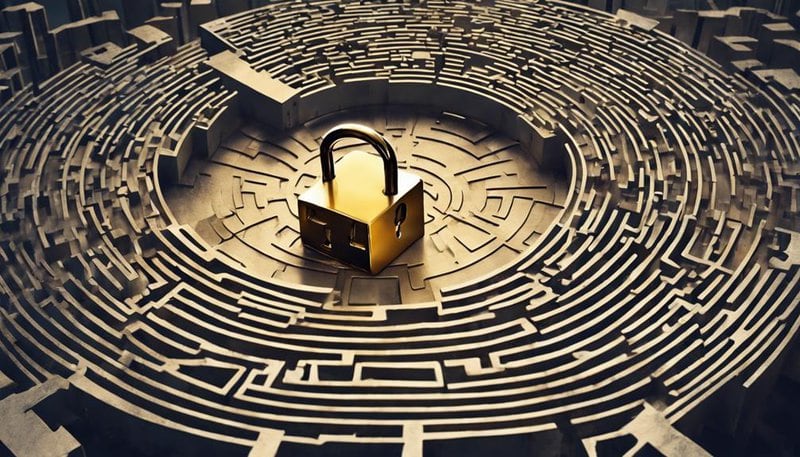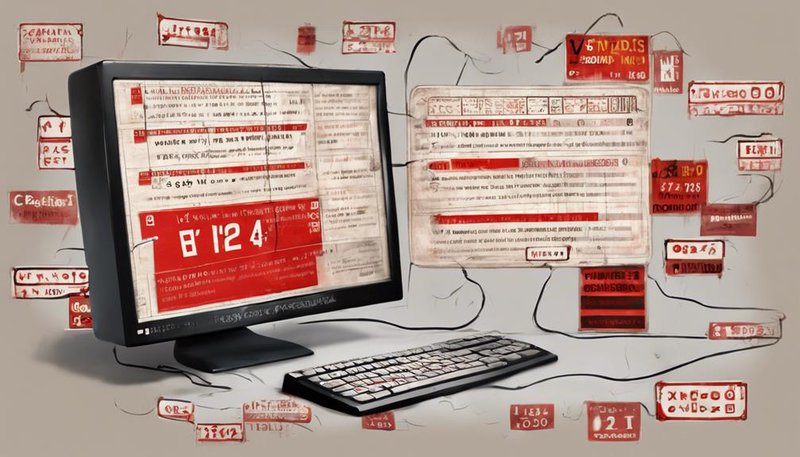Why Are Crypto Exchange Hacks So Common and How to Avoid Them

Crypto exchange hacks are common due to factors like inadequate security measures and human vulnerabilities, as seen in the Mt. Gox incident.
Understanding these risks and adopting strict security protocols is crucial to protect your assets in the crypto landscape.
Lack of Robust Security Measures
To safeguard your investments in the volatile world of cryptocurrency exchanges, implementing robust security measures is paramount. One key aspect of enhancing security is the implementation of multi-factor authentication (MFA). MFA adds an extra layer of protection by requiring users to provide two or more verification factors before gaining access to their accounts. This significantly reduces the risk of unauthorized access even if one factor is compromised.
Moreover, cybersecurity training plays a crucial role in fortifying your defenses against potential threats. Educating yourself and your team on best practices, common attack vectors, and how to identify phishing attempts can greatly reduce the likelihood of falling victim to cyberattacks. By investing in regular cybersecurity training sessions, you equip yourself with the knowledge and skills necessary to navigate the complex landscape of online security.
Insider Threats and Social Engineering
Enhancing your vigilance against potential threats involves recognizing the risks posed by insider threats and social engineering tactics in the realm of cryptocurrency exchanges. Data leakage, often facilitated by insiders with access to sensitive information, poses a significant risk to the security of crypto exchanges. Employees or contractors with malicious intent can exploit their privileged positions to leak confidential data, compromising the integrity of the exchange and its users' assets.
Moreover, social manipulation is another prevalent tactic used by threat actors to deceive individuals within the exchange. Through social engineering methods, such as phishing emails or fraudulent schemes, attackers can trick employees into divulging critical information or granting unauthorized access to the exchange's systems. This form of manipulation preys on human psychology and trust, making it essential for exchange staff to undergo regular training on identifying and thwarting such attempts.
Regulatory Gaps and Compliance Issues

Navigating the regulatory landscape in the realm of cryptocurrency can be daunting. Understanding the regulatory challenges and the significance of compliance is crucial for the security of crypto exchanges.
Ensure that your exchange meets the necessary regulatory standards to mitigate risks and protect user assets effectively.
Regulatory Challenges in Crypto
Regulatory gaps and compliance issues pose significant challenges in the cryptocurrency industry, demanding vigilant oversight and adaptation to evolving standards.
When navigating the regulatory landscape, keep in mind the following:
- Regulatory Obstacles: Understanding and complying with varying regulations across different jurisdictions is crucial.
- Industry Standards: Staying updated with best practices and industry guidelines is essential for maintaining compliance.
- Legal Complexities: Navigating the legal nuances of cryptocurrency laws requires expert guidance and a proactive approach.
- Government Oversight: Being aware of government scrutiny and ensuring transparent operations can help mitigate regulatory risks.
Importance of Compliance
For a secure and compliant operation in the cryptocurrency industry, understanding and adhering to regulatory requirements is paramount. Regulatory compliance isn't just a box to tick; it's a fundamental aspect of safeguarding your exchange and its users.
By ensuring strict adherence to regulations, you aren't only protecting your business from legal ramifications but also mitigating the risks associated with potential breaches. Implementing robust compliance measures is a proactive approach to fortifying your exchange against vulnerabilities that could lead to hacks or breaches.
Stay informed about evolving regulatory landscapes and continuously update your compliance protocols to stay ahead of potential threats. Remember, compliance isn't just a necessity; it's a strategic tool for enhancing the security and credibility of your exchange.
Vulnerabilities in Exchange Platforms
You must be keenly aware of the vulnerabilities that plague exchange platforms. Understanding these weaknesses is crucial to fortifying your defenses against potential security breaches.
Prevention starts with recognizing these points and taking proactive measures to mitigate risks.
Exchange Platform Weaknesses
Exchange platforms often fall prey to cyber attacks due to inherent vulnerabilities in their systems and processes. To protect your assets, it's crucial to understand the weaknesses that can be exploited by malicious actors:
- Lack of Proper Encryption: Ensure that all data transmission is encrypted to prevent intercepting sensitive information.
- Inadequate Authentication Measures: Implement multi-factor authentication to add an extra layer of security.
- Poor System Monitoring: Regularly monitor your system for any suspicious activities to detect potential threats early.
- Outdated Software: Keep all software up to date to patch any known vulnerabilities and prevent exploitation.
Security Breaches Prevention
To fortify your defense against potential security breaches, understanding the vulnerabilities present in exchange platforms is paramount.
Implementing cyber hygiene practices, such as regular software updates and employee training on recognizing phishing attempts, can significantly enhance your platform's security.
Data encryption is a crucial tool in safeguarding sensitive information from unauthorized access. Additionally, enabling multi-factor authentication adds an extra layer of protection by requiring multiple forms of verification for access.
Conducting regular penetration testing can help identify weaknesses in your system before malicious actors exploit them.
Poor Password Management Practices

Implementing strong and unique passwords for your crypto exchange accounts is paramount in safeguarding your assets from potential breaches due to poor password management practices. Here are four essential tips to enhance your password security:
- Strong Passwords: Create complex passwords with a mix of letters, numbers, and special characters to increase the strength of your login credentials.
- Unique Passwords: Avoid using the same password across multiple accounts. Each crypto exchange account should have a distinct password to prevent a single breach compromising all your accounts.
- Multi-Factor Authentication: Enable multi-factor authentication whenever possible. This adds an extra layer of security by requiring more than just a password for account access.
- Regular Password Updates: Change your passwords periodically to reduce the risk of unauthorized access. Updating passwords frequently can help thwart potential hacking attempts.
Phishing and Spoofing Attacks
Guarding against phishing and spoofing attacks requires a vigilant mindset and proactive measures to protect your crypto assets. Email scams, often used in phishing attacks, aim to deceive you into providing sensitive information such as login credentials or personal details. Be cautious of emails requesting urgent actions or claiming to be from legitimate sources, as these could be phishing attempts. Always verify the sender's email address and avoid clicking on suspicious links or downloading attachments from unknown sources.
Website impersonation is another common tactic employed by scammers to trick users into entering their login credentials on fake websites that resemble legitimate platforms. Before entering any sensitive information, double-check the website's URL for any slight variations or inconsistencies that may indicate a spoofed site. Ensure that the website is secure by looking for the padlock symbol in the address bar and using two-factor authentication whenever possible to add an extra layer of security to your accounts.
Stay vigilant and skeptical to safeguard your crypto holdings from phishing and spoofing attacks.
Lack of User Education and Awareness

Stay informed and educated to protect yourself against potential risks in the crypto space, particularly regarding the lack of user education and awareness. When it comes to safeguarding your assets in the digital realm, knowledge is your best defense. Here are four crucial points to consider:
- User Authentication: Always use strong, unique passwords and enable two-factor authentication whenever possible to add an extra layer of security to your accounts.
- Cybersecurity Training: Invest time in educating yourself about common cyber threats, phishing scams, and best practices for online security to minimize the risk of falling victim to malicious attacks.
- Stay Updated: Regularly monitor news and updates related to cybersecurity in the crypto industry to stay abreast of the latest threats and protective measures.
- Verify Information: Before taking any action or sharing sensitive data, verify the authenticity of the source to avoid falling prey to fraudulent schemes.
Third-Party Risks and Dependencies
To navigate the complexities of crypto exchange security effectively, it is essential to assess and mitigate third-party risks and dependencies. When considering the security of your assets on a crypto exchange, it's crucial to understand the potential vulnerabilities that can arise from the supply chain and the authentication methods used by third-party services integrated into the exchange platform.
| Third-Party Risks and Dependencies | Key Considerations |
|---|---|
| Supply Chain | – Evaluate third-party vendors for security protocols.<br>- Monitor for any breaches or vulnerabilities in the supply chain.<br>- Implement risk management strategies. |
| Authentication Methods | – Use multi-factor authentication for added security layers.<br>- Regularly update authentication protocols.<br>- Ensure third-party authentication methods meet industry standards. |
Importance of Cold Storage Solutions

Assessing third-party risks and dependencies is crucial; now, let's emphasize the paramount importance of implementing cold storage solutions in safeguarding your crypto assets. When it comes to securing your digital wealth, cold storage solutions are your best bet. Here's why:
- Hardware wallets: These physical devices store your private keys offline, making them nearly immune to hacking attempts.
- Multi-signature wallets: By requiring multiple private keys to authorize transactions, multi-signature wallets add an extra layer of security, reducing the risk of unauthorized access.
- Offline storage: Storing your cryptocurrency offline in cold wallets ensures that it isn't connected to the internet, making it extremely difficult for hackers to access.
- Protection against online threats: Cold storage solutions protect your assets from online vulnerabilities like malware and phishing attacks.
To fortify your crypto holdings, consider incorporating cold storage solutions like hardware wallets and multi-signature wallets. Your assets deserve the utmost protection, and these solutions offer a robust defense against potential threats.
Frequently Asked Questions
How Can Users Ensure the Security of Their Cryptocurrency Holdings Outside of Using Exchange Platforms?
To ensure your cryptocurrency's security, invest in hardware wallets for cold storage. These physical devices keep your assets offline, away from hackers. Safeguarding your holdings with this method adds an extra layer of protection.
What Role Do Government Regulations Play in Preventing Crypto Exchange Hacks?
Government oversight is pivotal in safeguarding your crypto investments. Regulations impose strict security standards on exchanges, holding them accountable for protecting your assets. Ensure exchanges comply with regulatory measures to mitigate vulnerabilities and enhance your safety.
Are There Any Alternative Security Measures That Can Be Implemented to Protect Against Insider Threats and Social Engineering Attacks?
To boost security against insider threats and social engineering, consider implementing multi-factor authentication. It adds layers of protection. Security training is vital to recognize and thwart these risks. Your diligence can safeguard against potential breaches.
How Do Third-Party Risks and Dependencies Contribute to the Vulnerability of Crypto Exchanges?
To understand the vulnerability of crypto exchanges, consider third-party risks and dependency vulnerabilities. These factors expose potential weaknesses that hackers exploit. Strengthen your security by vetting third parties and reducing dependencies for a safer exchange environment.
What Steps Can Users Take to Educate Themselves and Increase Their Awareness of Potential Phishing and Spoofing Attacks in the Cryptocurrency Space?
To protect your crypto, prioritize security education. Boost user awareness to spot phishing and spoofing. Strengthen defenses against attacks. Stay vigilant, verify sources, and never share sensitive information. Guard your assets with knowledge.








